To continue. Where is the deer? So, let’s say you have mastered walking quietly, that you can reason out where a deer has walked, and that you can see through the bush, so that if a deer is there it will be visible to you. Still and all, you need to also be looking in the right place. For example some places may be too thick, and though there may be lots of deer there, you may never see them. Such areas are better suited to hound hunting. The Upper Thomson springs to mind as an example.
You need to pay attention to the topography, rainfall etc. Say for example a river runs East-West (here in Victoria). The sun will heat the West facing slopes of the ridges more than the east. The gullies which run from South to North will be drier than those that run from North to South but they will also likely be more open and grassier. The heads of the latter gullies will likely be too thick for shooting. Deer will often prefer to bed on the North facing ridges on the South side of the river but out of the cold wind, in some dogwood or wattle for example where there is a bit of warm sunshine on a cold day. You should be able to see how the system of tracks leads to such spots by looking at where they begin and which way they trend.
When you do see a deer (or any quarry) do not look at it when it looks at you. And do not move. A single muscle. Unless you are going to shoot straightaway – maybe the best option in many cases, and one reason why I prefer iron sights. Mammals have the magnificent visual acuity they have for very good reason. The eye and brain are hard-wired to sound alarm bells whenever movement is detected, and the nervous system is brilliant at detecting it. Movement is always (potentially) dangerous.
Watch a cat stalking its prey: a mouse or a bird. In the presence of prey it will hold still for a very, long, while. When it does move the movement will be slow and smooth. Jerky, sudden movements always generate alarm. The only sudden movement is the final pounce.
Sometimes I have demonstrated to folk how to catch a wild wallaby by the tail. Whenever you see a wallaby, if you approach it very slowly and methodically, averting your eyes when it looks at you or looking away completely, remaining in a bent position as if you were another wallaby, even lowering your head right down to the ground, as if eating…you can walk right up to one and catch it by the tail. Try it for yourself. It is a useful exercise in stalking. A black wallaby is surprisingly hard to hold on to by the tail though. Do not try this with a grey kangaroo (I have). Let us just say that it is unwise, and that Spot learned straightaway from my demonstration not to approach the beasts at all! Me too!
It is possible to do this with a sambar deer. Of course it is most appealing to try it out on a mature stag. Again, make like a wallaby. A deer will have seen lots of them. It is the most common biped in its experience – and no threat at all to it. Indeed, it will flush them away if it feels like it. It is a matter of pattern recognition. Herbivores do not generally have the cognitive sophistication of primates. Mind you there are plenty of folks though who nonetheless have walked blithely into veritable lions’ dens!
Bow hunters become particularly good at getting up close to deer – because they must. Even without camo a skilled bow hunter gets to within 20 metres of the quarry regularly – probably almost every time they go out. Practice and experience. They don’t happen overnight. It might be a useful exercise for you to go out in just such a way sometimes, armed only with a bow – or a camera.
Once you get right up next to the sambar stag, you may overwhelmed by a wild temptation to simultaneously leap upon its back and seize it by its horns, perhaps thinking to cut its throat with your blade knife after some ‘slight’ tussle. This would be unwise in the extreme. Sometimes it is just very sensible to resist temptation! My late old friend Arthur Meyers found himself on a mature stag’s back in just such a circumstance many years ago. We were all victims of youthful exuberance once. He did live to tell the tale (and many others besides) and lived quite a long time, even more than me (so far), but he also regretted it considerably for some time!
I have also wrestled a stag to the ground by its antlers and cut its throat when I was younger. It was a seriously wounded stag, and I was out of ammo, so there was no other choice really – but I hope I never have to do the same again. I would not recommend this approach to anyone. Of course, if you had hold-down dogs it would be a different matter, Sir Samuel Baker dispatched 400 of the beasts in this way with just a bayonet.
Anyone who has wandered around the bush in pursuit of deer for many years will have had many such close encounters. I once found myself astraddle a doe in the Flourbag Creek, and bucked suddenly into the air and down again to a heavy, awkward landing on my shoulder amongst the ‘wait-a-while’ vines. Attempting to step over a sleeping deer you have mistaken for a log will get you into this sort of situation mighty quickly. So watching out over there for a deer instead of looking where you are putting your feet isn’t always the right advice, though I have given it more than once!
I guess I have been bowled over (or nearly so) by a running deer over half a dozen times and have only just managed to avoid their antlers on a couple of occasions too. They take fright pretty quickly and without much care as to direction when they bolt, being only mad keen to be gone from danger. I have even been in the midst of a stampede of probably 30-40 deer on the side of a valley off the Mitchell a few years ago. That was a minute’s heart-starting action, let me tell you! I guess it was my scent provoked the rush as there didn’t seem to be anyone else about. But they behaved exactly as if when danger threatens, it threatens all alike. And off they went. In a veritable thunder of hooves. Pretty much right over the top of me. The first impression I had was just the roar of hooves and the ground shaking. It took me a moment to even understand what was happening. Frightened me silly.
I have also been bowled over by roos and wombats which I think much more dangerous in some ways because of heir immense teeth. I reckon they could just about take a leg off if they set their mind to it. One of them tried to take a swipe at me once. I was nimble enough to avoid him, but what a maw he had!
First though, as I said at the outset, you have to find the deer – and where might it be?
Some people are immensely better at finding them than others. I once met a chap years ago on the Lazarini Spur. He used to just shoot the deer and take the tails as proof of his tally. On this day he had nine fresh-cut tails he tipped out of his day pack for me! As I said, this was thirty years ago, long before the deer population ‘exploded’. Whilst I do not condone such wanton destructiveness, I include the story to illustrate that it is possible to see (and shoot) a lot more deer than you are now.
This guy was able to do this just walking quietly through the bush bu himself (and with iron sights). No camo. No trail cams. No telescopic sights. Just his own unaided eyes and ears. His living proof that it was possible inspired me to give much more thought about how to do so.
Clearly seasons, time of day, the moon, changing feed (and water) conditions, the presence (or absence) of other hunters, oestrus, birthing & etc all create separate conditions which determine the deer’s whereabouts. Nonetheless there are always some good places to look, eg: feeding areas, bedding areas, nursery areas, scent marking, wallows, crossings…
A BTW: Drinking spots: mostly the deer using them will be does. The demands of lactation and pregnancy require more water. Most of the year most deer (especially stags) can get all the water they need from the food they eat (as do sheep). Sometimes the deer will be up high (when birthing and when the fauns are very young for example – where there is often no water source, though sometimes I’m sure you have noticed a tiny stream will be flowing high up which dries up or goes underground lower down. There are also often spring scrapes too deep under tree ferns where it appears no water exists.
Often a group of does will have a stag with them, but most often it is just a spikey or an immature stag. The master stag does not need to hang with the does save in the rut. He will chase the young stag away then mighty quick! He will never be far away down wind. Bachelor stags (the most numerous kind) often hang together high in valleys together and never go near the does. Quite often they are the most handsome and largest – just like Rock Hudson I guess. I have seen as many as seven sambar stags together like this. Here is a cohort of bachelor fallow as an example, snapped on my evening walk (with two Jack Russells!):

All these areas have game trails leading to and away from them. The trails converge and diverge. Clearly where they converge is a highly desirable spot for deer, for whatever reason – usually feeding, bedding, scent marking (think eg wallows). These are the areas where the cowboys place their trail cams and their ambuscades.
Deer are just as lazy as you (unlike wombats who seem to like to climb vertically). Their paths take an easy line up the ridges and gullies. For that alone they are worth following, but get to know the angle of those line so you can anticipate where the paths will be (in the general topography) and where consequently the deer will be. You should be able to spot the really likely hot spots from the river bottom kilometres away and plan a strategic route for intersecting them as furtively as possible..
I know you will likely shoot more deer just waiting quietly (until dusk probably, or after) in such spots, but it would not be fair. You should go seek out the quarry where he has the opportunity to use all his senses to avoid you and escape – else there will be no sense that taking him makes a worthwhile trophy, representing something difficult and well done. Anything else is mere affectation. It will be not much better than having shot him on the road in the light of your car’s head lamps really, and that is too easy to do – as I notice from the evidence on the side of the road practically every time I go up the bush.
The game trails are not unlike a human road system; they branch and branch: there are freeways, then highways, then back roads, and finally driveways. You may remember my photo of Della on the post http://www.theultralighthiker.com/pack-rafting-the-wonnangatta-mitchell/, along with the comment: ‘This, believe it or not, is a deer path on public land! This would be a good place to be at dusk with a .308 – if you were hungry!’
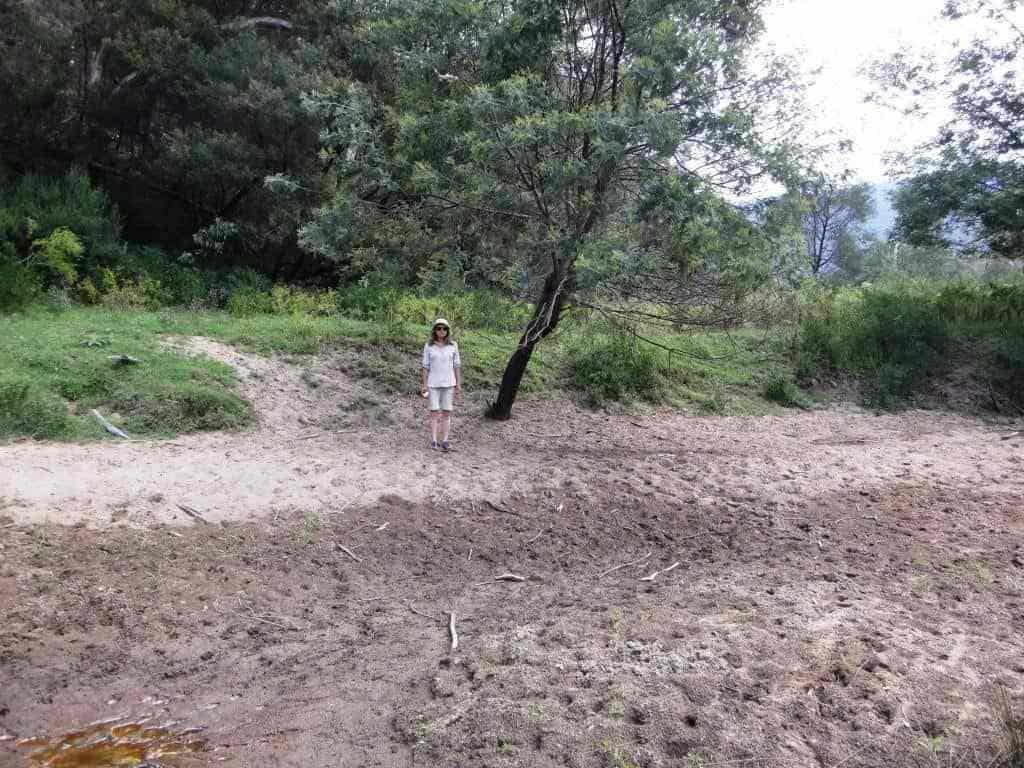
This is a deer freeway, nearly a chain wide! Clearly they must have some compelling reason to cross the river in such numbers at this point. Such numbers as this are always down to feed, and when I say ‘feed’ I mean pretty much pasture, just as if they were sheep or cattle, as pasture is their chief food whatever else they might eat (and they eat many things). There is plentiful pasture in the bush along open valley sides for example.
That is why I have said before that you will always find deer bedded behind a farmer’s paddock, no matter how much effort he has made to reduce their numbers – and I know one who has shot hundreds of them in a the last year alone! If you are a farmer (as I have been for over forty years and want to preserve your livelihood, you are going to either have to fence out whatever critters prey on your income or seriously reduce their numbers – whether it is legal to or not!
I had a client who lost over 800 Merino ewes in a single night to dingoes, for example. Once I went out with an old friend one night and counted over 3,000 roos in his wheat paddock (in Northern NSW). We built a huge pen in the corner, rounded them up and seriously depleted their numbers, else there would have been no crop that year! It was quite legal to do so then.
With a bit of practice you will get a map in your head of where any system of game trails goes to and comes from. Right at the top (the driveway) is where you will find the biggest stags, save in breeding season – and they do have a season, though many young are born out of season. You can sometimes see a huge increase in competitive stag behaviour for example: thrashing, rubbing, preaching, push-and-shove grounds, howling and clashing etc. This is clearly the mating season. At other times (in the bedding areas) the ferns are packed with piles of tiny droppings and you will often trip over a fawn sleeping next to a tree. It is quite easy to catch hold of one in such circumstances (though you should not), as they are programmed to ‘freeze’ (just as lambs are) until mama comes back for them! You should definitely not take one home to bottle raise, particularly of it is a stag. Even a very ‘tame’ bottle raised stag will one day turn on you. People have been killed by just such stags.
The stags can smell the does are in oestrus from at least a kilometre away. They do not need to move until they are so lured. That is why they will invariably be camped uphill and downwind of the does. When they are in rut they are just as silly as any other bunch of young blokes out for a night on the town, drunk as lords and hoping (usually against hope) to get their legs over. They are as mad as March hares.
And reek – rather like the young fellows with their excesses of deodorant. If you shoot a stag in rut you will have trouble eating the meat. I know I can’t. It’s just too gamey for me. It can have been in the freezer for six months and will still stink terribly when thawed out. When they are in rut if you have any sort of nose at all you can follow this rut scent up the wind right to the stag who is making it! (They are usually monstrously inattentive at such times. I’m sure that is when most stags are taken).
You should practice walking without making any sound at all. If you buy yourself a pair of cheap hearing aids such as Walkers Game Ears and you turn them up fairly loud they will alert you to just how much noise you are making. They will teach you to glide – like that cat. If you can hear yourself, obviously a critter with ears ten times as big as yours will be able to easily too. Such devices are good too if you are a bit hard of hearing (my own is too far gone for the best aids to make enough difference).
It seems like only yesterday that I could hear the high pitched shrieks of bats hunting of a night, and at the other end of the spectrum I could hear the hum of the power station chimneys four kilometres away. I have completely lost those high frequencies. I need 85 decibels of amplification to hear any of them. The low frequencies are not quite so bad. I can usually hear a roo crashing off, but I can no longer make out a doe stamping – which should be a dead giveaway for you if your ears are still OK. They stamp before they honk. If you hear that noise, get down at once. Wait. Then move very slowly, looking carefully. There is usually a group of them so it is very likely one will see you before you see them, but you will get better at it.
Before i was quite deaf I had the fact I was losing my hearing underlined for me one day years ago. I was walking quietly down a track with a friend, wending our way down to the verdant valley below to what I though might be a ‘good spot’. I had a particularly prolific bedding area in mind. Suddenly he whispered, ‘Listen’ – which I did, but to my ears, there was nothing. I was utterly astonished when he quietly stepped off the track and took a (successful) shot at a nice fat hind! His superior hearing had been able to pick up her faint movements in the bush. She had not even stamped. A pair of these ‘Game Ears’ might get your hearing back to that level! I have to rely on my ears and my nose.
Hearing aids are good for protecting your hearing too as they Doppler down to a maximum volume when you take a shot. These ‘Game Ears’ are also some of the cheapest hearing aids on the market. If you think you might need hearing aids you most certainly do! Try some. If you put off getting them you are causing your hearing to worsen more than it otherwise would have. Act now.
Birds can be your greatest enemies. They have such a predisposition to fly up when alarmed. If you can avoid alarming them you should, ie if you spot them detour. Flying is such an energy demanding pursuit that birds only take flight at need. You have surely noticed how many birds starve to death each winter as compared with other sorts of creatures? As I said, the demands of flight are huge.
Mind you it must be a marvelous thing to be able to do. It is hard to imagine how once having mastered it anything could possibly give up its obvious pleasures and practicalities, as the dodo and the moa to name a couple clearly did. Oh well. Of course their startle response to something large moving near them can also be put to your advantage. You must have noticed how various birds, particularly pigeons, kookaburras and the various magpies give a clear warning (by rising up &/or calling) that a deer is passing by where they are – somewhere up front of you?
It will be moving away from you, probably alerted by your scent eddying about on vagrant airs. As it is passing them, this gives you a line of its travel. It is not much troubled yet and will quickly settle again if undisturbed. You could note the line it is taking, estimate where it will stop, wait a little while till you are sure it would have settled, then begin a circuitous approach. It will definitely be watching its back trail so you must approach from some other downwind direction which offers good cover.
I like to get up above the major stream to about the height I reckon deer will be bedded at that time of day and year, and just gradually work my way (into the wind) crossing from (the head) of side gully to side gully. I enjoy walking all day anyway and would be bored (as well as cold) just sitting around waiting. Besides you see lots of interesting things moving along: a myriad wildflowers, the lambent blue of an emu’s egg lying solitary on the shingle, some long-ago abandoned relic of long ghosted folks: the inside of an alarm clock perhaps, or the rim of an ancient kero tin…
I guess you only get a shot at perhaps only 20% of deer you put up in this way, and they are often up and off in a hurry if you are not particularly careful about how quiet you are being, which I am usually not any more – as I really just enjoy the walk these days, and usually have a Jack Russell or two for company, so that there’s not much point in being quiet anyway.
In such (noisy) circumstances it is usually snap-shooting through bush where the first shot is the only one that counts, so the rifle probably goes up at least half a dozen times between shots. I like to do a complete circuit of a large valley (as I said) in this way during the day and finish up somewhere near where I began – to camp on the flats at the bottom with a nice warm fire in front of my cosy shelter and just the stars and the dogs for company. Something like this or this.
What to do when you see a deer. Maybe I can best illustrate this with this series of photos taken on my afternoon walk with the dogs yesterday (I know this is a small fallow stag; the same points apply to other species). The snaps are a little grainy due to the failing light:
If you come around the corner or over a rise and you see a deer in this position you must freeze. This one is about 250 yards away. Deer (likely) have better visual acuity sideways than you do (unless you too have been hunted a lot). He will therefore likely notice any movement straightaway and react. Here he is quite relaxed, ears down. He is also too small to take except for the table where he should taste just about as good as any lamb!
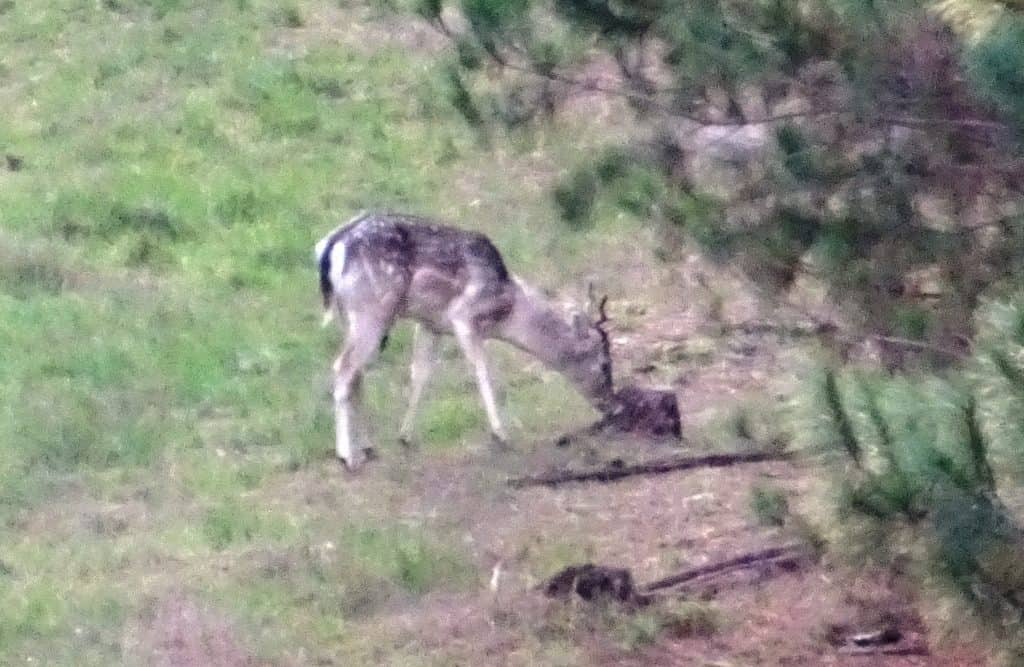
If you don’t move he will go about his business – in this case feeding on some lush pasture – as you can see. You can creep up quietly while his back is turned trying to keep as much cover as you can between him and you so that when he turns this way you can freeze but he will not be able to make you out as your outline (because of the cover – or if you are crouched) will be broken up.
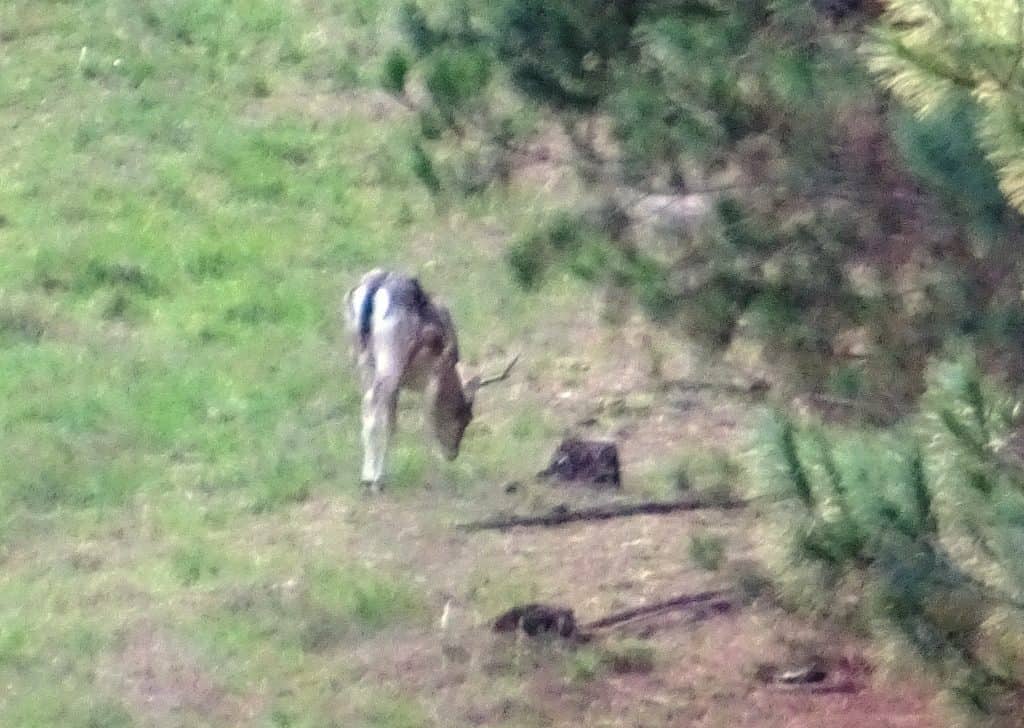
He is just going to continue to go about his cervine business. You could creep closer (as above) or creep along in cover out of sight then slowly riase your head up for a closer look. Of course I realise that right at the start he was close enough for a sure shot with a telescopic sight. I do not use them as they reduce the deer’s ability to use its senses so are unfair. He would not be a trophy unless you show outstanding skill, you see. Now I will want to get to say within fifty yards for a sure shot with iron sights. Of course (when I was younger certainly) I could have shot him at 300 yards with iron sights without a rest – but we all get old! Hope you enjoy it as much as I do!
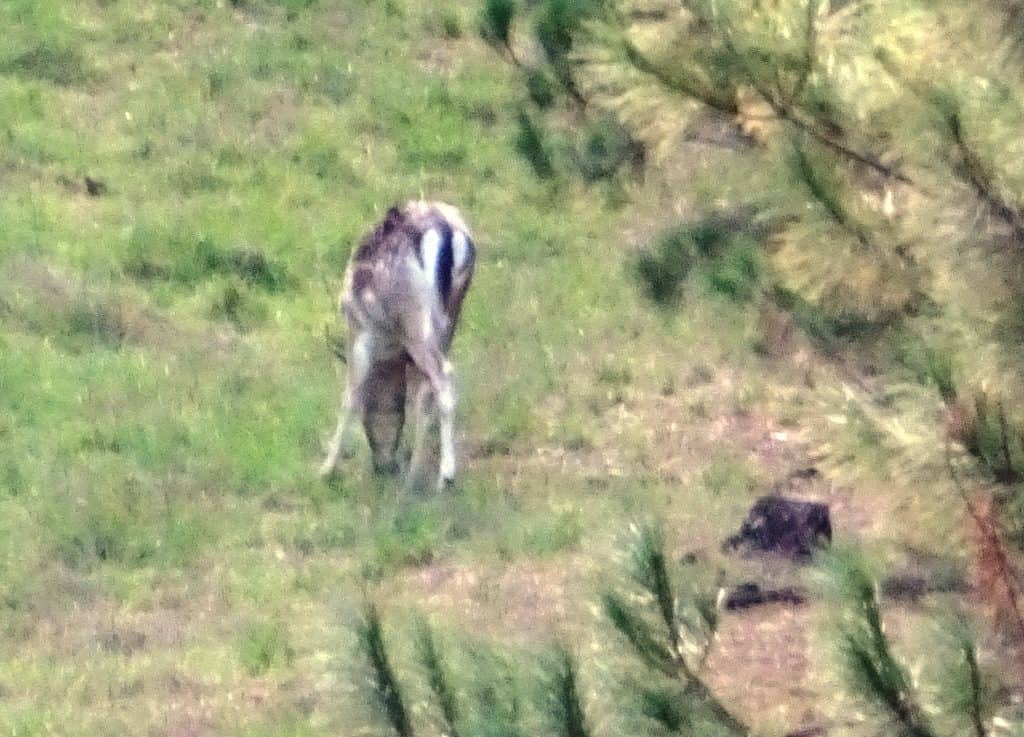
Now you see his head has come up (and his ears). He has noticed something (probably the two dogs who are romping in plain sight), but maybe it is just a sound. If you saw him begin to do this you could slowly crouch over (reducing your threat level) and freeze. Don’t look straight at him! Likely he will just remain attentive for a minute and go back to grazing – in which case you can resume your stalk.
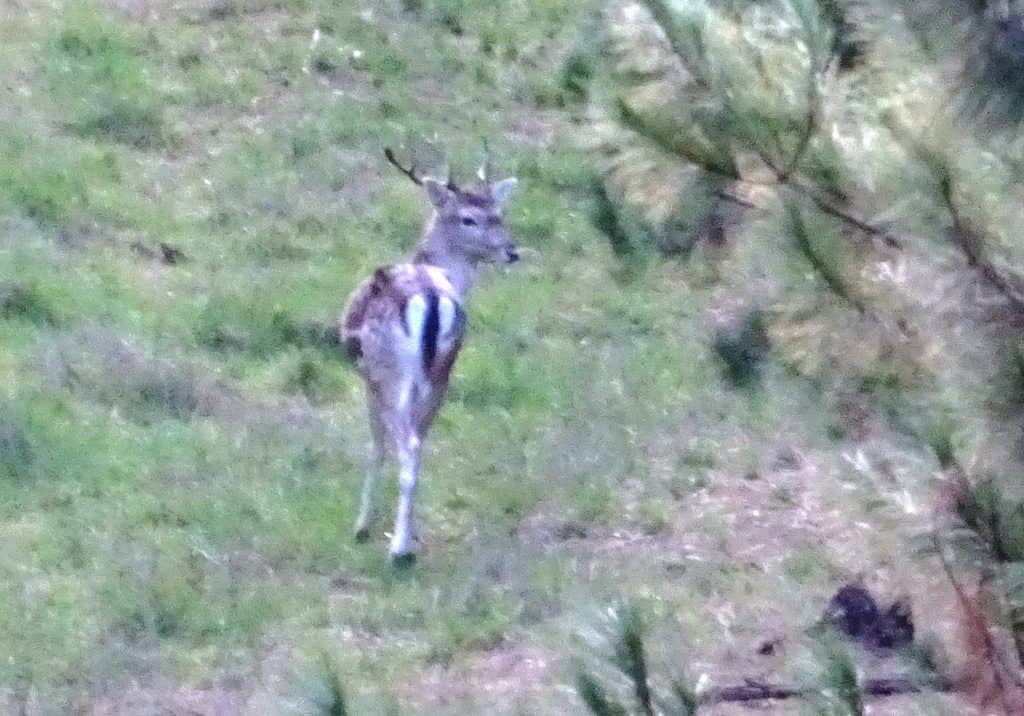
Now he is watching (the dogs) and listening intently. His muscles have tensed up ready for flight. If you are frozen (preferably in a bent over position), and you don’t have two dogs running around, he will still most likely quieten down again and resume feeding. Wait. If you had not alerted him to this level, you could likely have crept up to inside 20 yards of him (using cover), being dead quiet and being very patient (and so long as you are downwind).
He stood like this for over a minute watching the dogs fool about, then decided to slowly sneak off into the trees. BTW: For some bizarre reason fallow stags seem always to have their pizzle hanging out like this.
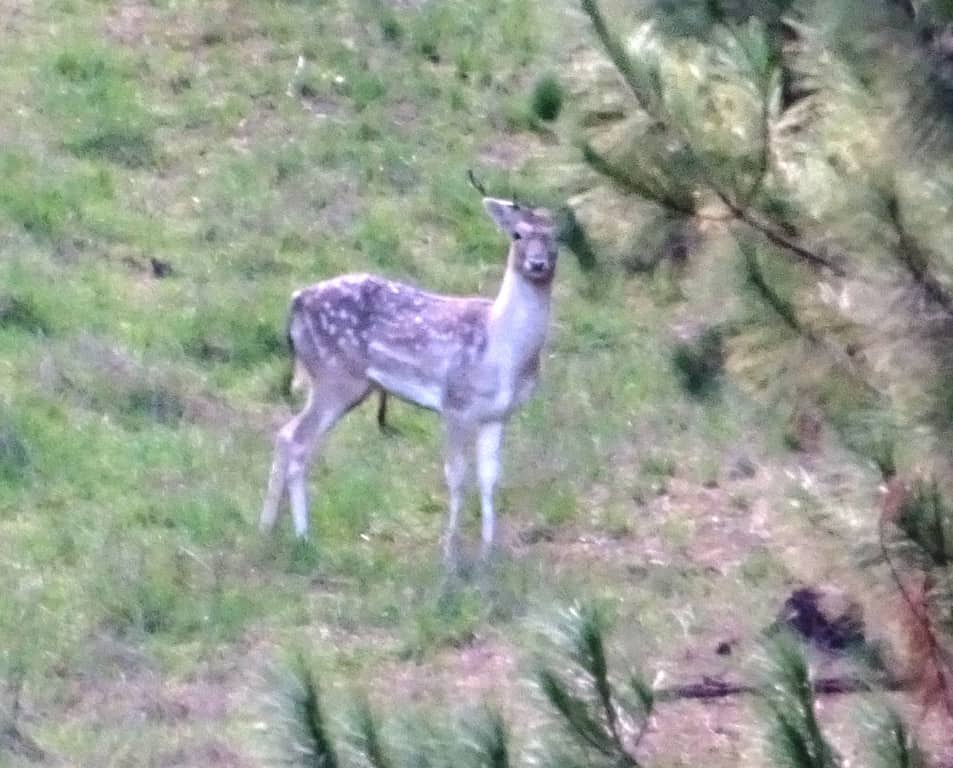
PS: Another of my ‘apprentices’ recently took his first sambar stag, a small spikey. This is a significant achievement and no doubt will be the first of many, as he has learned a lot. As he is also a qualified chef, I think the family will be delighted with this addition to their larder:
Such a sweet little trophy. he will remember this for many years. I can tell from the shape of this guy whereabouts he likely shot it. There are quite clear discernible ‘races’ amongst our sambar deer.
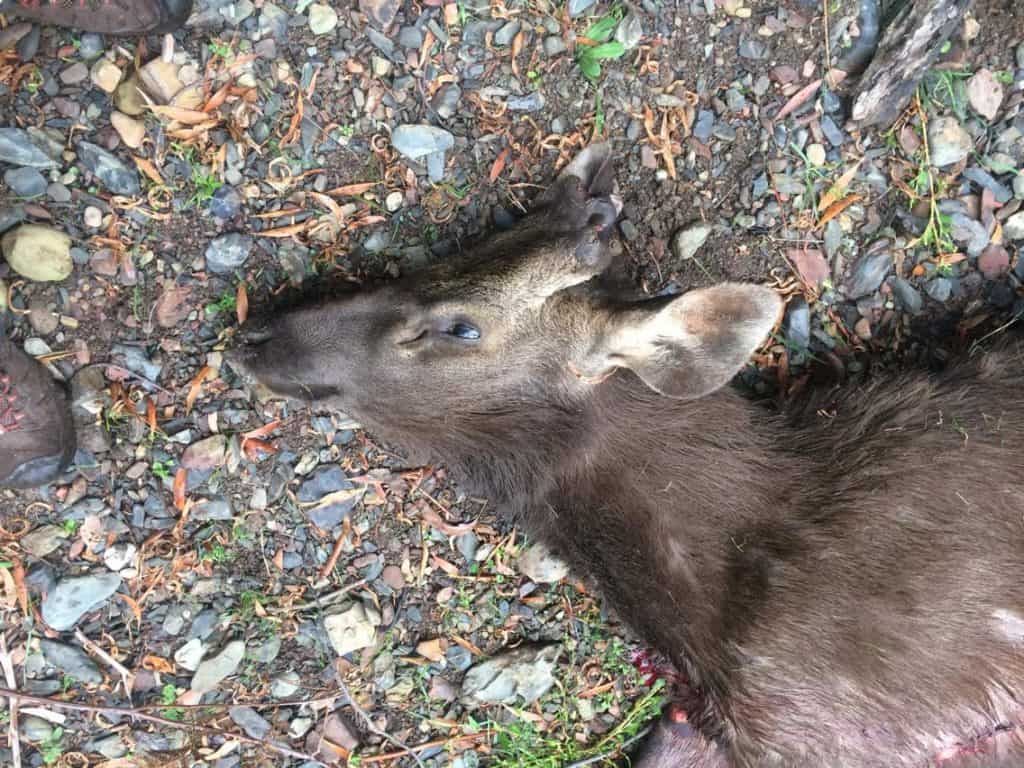
Some careful dissection work ahead:
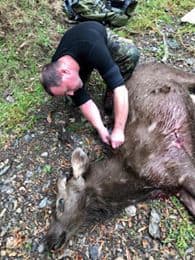
The carcass has been well (and cleanly) butchered and all the meat was carried out to be consumed at home.
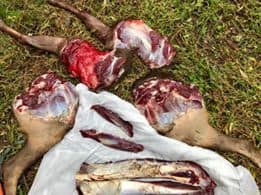
PPS: Amerindians had a custom of ‘counting coup’ eg on their enemies (instead of killing them), so that they would show their bravery and skill by coming close enough to touch them. This might be a good idea to practice on deer as in this video kindly sent to me by a young friend:
I think this poor young stag has been blinded in a fight – damaged optic nerve probably; maybe hearing impaired too. We had a ram which this happened to a few years ago (always your best ram, dammit). The ram did not recover or survive. Likely this guy will not either, and should be harvested – as a kindness. I think you will have a bit more difficulty having a healthy stag stand for this kind of treatment, but why not give it a try?
Stags can also get tangled when fighting, though I think this is much less likely with sambar due to their fewer points than might be the case with reds or fallows. I was trying to find an example of this when I found this interesting footage from somewhere in Fiordland:
Here are two tangled in a fence though:
https://www.youtube.com/watch?v=8vSqwpEPdvA
You would wonder how this lady hunter got so close as to leave her bra on this stag’s antlers:
I don’t usually watch videos, but…this really is ‘counting coup’ on an elk. Amazing:
Good luck with your hunting!
Some recent hunting related posts:
http://www.theultralighthiker.com/the-deer-hunters-apprentice-1/
http://www.theultralighthiker.com/the-deer-hunters-apprentice-2/
http://www.theultralighthiker.com/the-lure-of-the-moose/
http://www.theultralighthiker.com/best-hunting-daypack/
http://www.theultralighthiker.com/ultralight-cookpot/
http://www.theultralighthiker.com/ultimate-blades-for-the-ultralight-hunter/
http://www.theultralighthiker.com/crkt-pdk-replacement-blades/
http://www.theultralighthiker.com/fire-umbrella/
http://www.theultralighthiker.com/are-you-beautiful-in-the-buff/
http://www.theultralighthiker.com/a-spot-of-solitude/
http://www.theultralighthiker.com/nz-moose/
http://www.theultralighthiker.com/follow-your-nose/
http://www.theultralighthiker.com/hunting-thumbtack-reflectors/
Some Other Hunting Adventures:
http://www.theultralighthiker.com/thrilling-tales-sir-samuel-baker/
http://www.theultralighthiker.com/a-gorilla-in-the-bush/
http://www.theultralighthiker.com/hammock-hunting-till-dark/
http://www.theultralighthiker.com/no-sew-sandals/
http://www.theultralighthiker.com/gippsland-pack-rafting-routes/
http://www.theultralighthiker.com/you-take-the-high-road-and-ill-take-the-low/
http://www.theultralighthiker.com/wonnangatta-waterford-to-angusvale-day-one/
http://www.theultralighthiker.com/sambar-stalking-101/
http://www.theultralighthiker.com/sambar-deer-stalking-102/
http://www.theultralighthiker.com/sambar-deer-stalking-103/
http://www.theultralighthiker.com/sambar-deer-stalking-104/
http://www.theultralighthiker.com/the-silence-of-the-deer/
http://www.theultralighthiker.com/avon-river-walking-track/
http://www.theultralighthiker.com/does-spot-like-to-hunt-deer/
http://www.theultralighthiker.com/spots-hunting-adventures-1-mystery-river/
http://www.theultralighthiker.com/spots-adventures-mystery-river-2/
http://www.theultralighthiker.com/spots-hunting-adventures-mystery-river-3/
http://www.theultralighthiker.com/not-quite-alone-in-the-wilderness/
http://www.theultralighthiker.com/hammock-hunting-till-dark/
http://www.theultralighthiker.com/you-take-the-high-road-and-ill-take-the-low/
http://www.theultralighthiker.com/hammock-camping-double-bunking/
http://www.theultralighthiker.com/backpacking-gear-advice/
http://www.theultralighthiker.com/dusky-track-adventures-1/
http://www.theultralighthiker.com/dusky-track-canoeing-the-seaforth/
http://www.theultralighthiker.com/hunting-in-fiordland/
http://www.theultralighthiker.com/moose-hunting/
http://www.theultralighthiker.com/westies-hut/
http://www.theultralighthiker.com/hammock-hunting-till-dark/
http://www.theultralighthiker.com/a-gorilla-in-the-bush/
http://www.theultralighthiker.com/you-take-the-high-road-and-ill-take-the-low/
http://www.theultralighthiker.com/the-last-of-the-mountain-men/
http://www.theultralighthiker.com/a-soft-pillow-and-a-warm-bed-under-the-stars/
http://www.theultralighthiker.com/if-you-could-only-carry-two-things-in-the-bush-what-would-they-be/
http://www.theultralighthiker.com/the-importance-of-a-roof/
http://www.theultralighthiker.com/the-deer-hunters-tent/
http://www.theultralighthiker.com/ultralight-shoes/
http://www.theultralighthiker.com/the-silence-of-the-deer/
http://www.theultralighthiker.com/avon-river-walking-track/


A great read as always Steve, like you I’m very hard of hearing,so I purchased a pair of Howard Leight Impact sport shooting ear muffs with twin microphones, and they are ten times better than my hearing aids, which annoy the hell out of me” these muffs amplify sounds spectacularly and cut gun shots down to 85db yet let you hear the thud of a bullet striking home, I’ve only used them fox hunting can’t wait to try them out on deer!, oh you can get them on on
Ebay under a $100, and now I really move like a Ninja and not just think I am”.
Cheers Trev
They are certainly a lot cheaper than the Game Ears or hearing aids (though they may not be ultralight!) Glad to hear they worked for you.